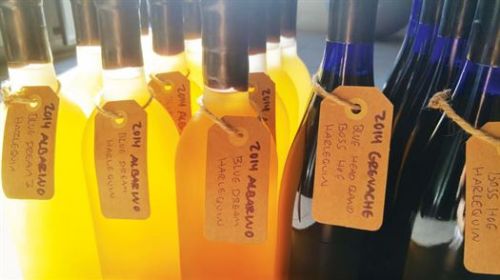Sommeliers Choice Awards 2023 Winners
Making wine with biodynamically farmed grapes — and marijuana
The result is Canna Vine, a high-end marijuana product that combines organically grown marijuana and biodynamically farmed grapes, made with the care and meticulousness of Opus One

The road to California’s first commercially available pot-infused wine begins on a camping trip in Yosemite National Park in 2010. There, Lisa Molyneux, a Santa Cruz dispensary owner and pioneer in marijuana retail, is introduced to the therapeutic properties of an especially good bottling purveyed by Louisa Sawyer Lindquist, owner of Verdad Wines in Santa Maria. For Molyneux, an ebullient cancer survivor who became a grower and founded her shop, Greenway, to aid fellow survivors, that evening at the campfire got demonstrably mellower. By the next day Molyneux and Sawyer Lindquist were already talking about working together.
The result is Canna Vine, a high-end marijuana product that combines organically grown marijuana and biodynamically farmed grapes, made with the care and meticulousness of Opus One. Advocates include Chelsea Handler and Melissa Etheridge — in fact, Etheridge has her own line of wines, called Know Label, also made by Molyneux — and other celebrities have expressed interest in having their own versions. And it comes with a price — anywhere from $120 to $400 a half-bottle— that alone might prove irresistible to other California winemakers.
Pot wine, also known as green wine (described, for legal reasons, as a “tincture”) has probably been around almost as long as there has been pot and wine. In California its modern inception is usually traced to the late ’70s and the winemaking crew at Chalone Vineyard, which is situated in an inland wine region near Pinnacles National Monument, miles from civilization (and the arm of the law). There, growers could cultivate both ingredients and perfect their methodology in relative secrecy. Winemaker Billy Wathen learned his craft there, and when he moved on to Foxen Winery in the Santa Maria Valley he passed his knowledge along to colleagues and friends. In this way, Santa Barbara County became a hotbed for such practices; when asked who among his colleagues has made some version of green wine, Wathen tends to look askance, as if to say, “Who hasn’t?”
Qupé winemaker Bob Lindquist (who is Louisa Sawyer Lindquist’s husband) is one of Wathen’s acolytes and has himself passed on the secrets of green to others, such as Sonoma winemaker Pax Mahle, who became a practitioner in earnest after a “summit” of green wine producers in 2011 in Big Sur, which may or may not have resulted in naked fire dancing at the Henry Miller Library on a moonlit night. Conversations about green wine sometimes go on such side routes.
It became commonplace to see infusions passed around at parties and unsanctioned events, which is how I was introduced and where I learned (to my relief) that infusions of this type are generally more pungent than potent, since fermentation temperatures rarely exceed 90 degrees. This is high enough to release cannabinoids (one of many active agents in pot) but not high enough to “decarboxylate,” or release, the THC, the most psychoactive substance in marijuana. The result is a mellow, physical “body high” rather than a more disorienting mental high. This property, somewhat unique among the ingestible forms of marijuana, was what made it so compelling to a healer like Molyneux.
“What’s nice about it is how subtle it is,” she says. “There’s a little flush after the first sip, but then the effect is really cheery, and at the end of the night you sleep really well. It really is the best of both worlds; you get delicious wines with medicinal benefits.”
Etheridge, a cancer survivor herself, knows those benefits firsthand. “When I was in my deepest, darkest, last throes of chemo,” says Etheridge, “I couldn’t smoke or use a vaporizer — and I was never really an edibles eater; I didn’t want to be ‘out of it.’” Molyneux’s tincture seemed to solve some of these issues. “It lands in a really beautiful place.”
This coming harvest Sawyer Lindquist will deliver pressed-off juice to an undisclosed location in the vicinity of Santa Cruz (green wines are inevitably made and stored in other facilities, to safeguard a winery’s bonded status). Molyneux will wrap about a pound of cured marijuana in cheesecloth and add it to a barrel, where it will ferment, then repose, for a year or more.
Molyneux makes the wine, but both she and Sawyer Lindquist have explored blends of the two weed types, sativa and indica, to find a balance between uplifting and relaxing sensations. They’re also actively seeking to combine the flavors of cannabis and the flavors of wine into something more harmonious. There’s a strain of cannabis that’s somehow pineapple-scented, for example, and Sawyer Lindquist says it pairs exceptionally well with Viognier fruit. And the weed strain Molyneux calls “Cherry Pie” is quite compatible with Grenache rosé. Others feel it’s just fine on its own, provided you like things herbal. “It smells good, like fresh bud,” says Mahle. “I love the taste and flavors of marijuana, so to me it’s really delicious.”
Continue to read about Making wine with biodynamically farmed grapes









